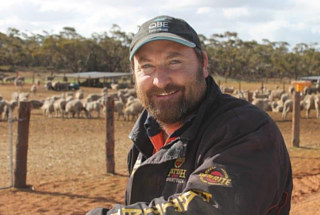Drought case study – Carwarp

Simplifying stock management at busy times of the year is one of the unexpected advantages Mallee farmer Jason Marwood has noted from using containment areas on his Carwarp property.
The Marwood family developed their first containment area years ago — but Jason is changing direction and has used the pens more strategically in recent years.
They’re not only providing better turnoff results, but operationally they’re allowing Jason to manage busy times of the year more efficiently, and with less stress.
'I will probably put all my sheep in at seeding time in future because you know where they all are, they don’t need to be moved from one paddock to the other, and it’s much better for monitoring their condition and what they are up to.'
'It’s quite quick to check them, do the daily watering and health checks — but going around them in the paddocks is a half-day job, which is time you just don’t have at seeding time.'
Site selection
The Marwood’s chose a relatively flat site on well-drained lighter soil.
'The site is close to the hayshed, silo and our other stock management facilities just for practicality,' Jason said.
'It’s tucked in behind a hill and we pushed it up as close to the treeline as we could to make it as sheltered as possible. It’s a flat site, but the soil is sandy and that’s been good because even after a lot of rain it isn’t muddy at all.'
One pen is maintained as a quarantine site, where all stock sourced from outside properties are held before they’re shorn, and backline treated for lice.
Water
The property is reliably supplied with water from a pressurized system from the Murray River. A 20,000-litre holding tank provides a secure on-farm supply and troughs in the containment areas are supplied from a two inch pipeline. Six hundred litre water troughs are used and are cleaned out daily.
Design and feeding
Each of the areas are about 50 × 50 metres in size and designed to hold up to 500 sheep. Five pens run either side of a centre laneway running the full length of the yards.
A water trough and bulk feeder is in each yard, along with access to salt. Large hay and straw bales are readily available, fed from the ground. A new site is used when each new bale is fed, to reduce erosion and distribute the remaining fibre across the yard.
Jason installed shelters in each yard for shade. The structures, about 1 to 1.5 metres high, were constructed from second-hand tin, timber and treated pine posts and are being well-utilised by the sheep.
'Being so low, the sheep seem to like getting in under them and in that way, they’re quite practical. I was a bit afraid they might get on a roof, but that hasn’t been a problem so far.'
Stock management
Use of the containment areas allows Jason to hold on to stock much longer than would have been possible using paddocks alone.
'It’s definitely a process I’m learning more about and plan to use more in the future.'
More information
For more information on managing during drought and dry seasonal conditions see Dry seasons support.
Contact your local Agriculture Victoria extension officer or call 136 186.